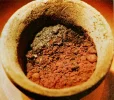- Time of past OR future Camino
- VdlP(2012) Madrid(2014)Frances(2015) VdlP(2016)
VdlP(2017)Madrid/Sanabres/Frances reverse(2018)
It’s 50km north of Alcaracejos - but Almaden is well worth the inconvenience of a detour from the Camino Mozarabe. My wife and I visited Almaden in 2018 on our way from Merida to Cordoba.
A spectacular mercury ore body has attracted serious mining operations since antiquity, and it is recognised as a geological wonder. Since records were kept, more than a quarter of a million tons of mercury has been extracted - a full third of total world production, and there is plenty left in the ground since operations ceased in 2003.
The mercury is in the form of a sulphide, a massive blood red mineral called cinnabar. All you have to do is roast it, and the sulphur is driven off as SO2 and you are left with quicksiver.
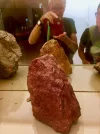 This sample is in the mining museum, one of the most fascinating I've visited.
This sample is in the mining museum, one of the most fascinating I've visited.
The Phoenicians, Carthaginians and Romans valued it as a source of pigment, vermillion. (A vessel of mercury dating back 3500 years was even discovered in Egypt).
 Vermillion pigment dazzles in this Roman frescoe.
Vermillion pigment dazzles in this Roman frescoe.
The Romans certainly used it for its remarkable ability to dissolve gold and silver from its ore. Here’s a cool video of gold amalgamation.
The moors developed its uses in medicine, which persisted in some cases right up to the 20th century.
It is still used, hazardously, by "artisinal" miners in some countries, particularly Indonesia.
Almaden’s most significant contribution to global history came in the 16th century, when enormous quantities were shipped in leather flasks to the Americas to extract the wealth from silver mines like Potosi in Peru. The bullion, by royal decree, ultimately returned to Seville.
Almaden mine is now a world heritage site, and you can tour the upper level of the underground mine. We were the only ones on our tour. The guide spoke enough english to be thoroughly engaging. I loved it - and gave him a big tip!
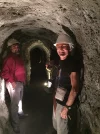
The gate to the mining compound dates from Carlos IV, late 18th century.
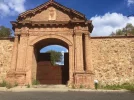
An impressive mule-driven underground timber winch used to haul ore from deeper levels. (Not my picture - my iphone photo was a dud).
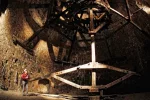
And as a bonus, the main hotel in Almaden is the partially converted bull ring. A real treat. this taken just ouside the door of our room.
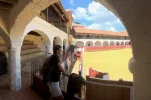
As a quirky post script, I've just finished reading book 18 of Patrick O'Brian's Aubrey/Maturin series. At the climax he captures a privateer carrying a valuable cargo looted from a galleon. Guess...
A spectacular mercury ore body has attracted serious mining operations since antiquity, and it is recognised as a geological wonder. Since records were kept, more than a quarter of a million tons of mercury has been extracted - a full third of total world production, and there is plenty left in the ground since operations ceased in 2003.
The mercury is in the form of a sulphide, a massive blood red mineral called cinnabar. All you have to do is roast it, and the sulphur is driven off as SO2 and you are left with quicksiver.
 This sample is in the mining museum, one of the most fascinating I've visited.
This sample is in the mining museum, one of the most fascinating I've visited.The Phoenicians, Carthaginians and Romans valued it as a source of pigment, vermillion. (A vessel of mercury dating back 3500 years was even discovered in Egypt).
 Vermillion pigment dazzles in this Roman frescoe.
Vermillion pigment dazzles in this Roman frescoe.The Romans certainly used it for its remarkable ability to dissolve gold and silver from its ore. Here’s a cool video of gold amalgamation.
The moors developed its uses in medicine, which persisted in some cases right up to the 20th century.
It is still used, hazardously, by "artisinal" miners in some countries, particularly Indonesia.
Almaden’s most significant contribution to global history came in the 16th century, when enormous quantities were shipped in leather flasks to the Americas to extract the wealth from silver mines like Potosi in Peru. The bullion, by royal decree, ultimately returned to Seville.
Almaden mine is now a world heritage site, and you can tour the upper level of the underground mine. We were the only ones on our tour. The guide spoke enough english to be thoroughly engaging. I loved it - and gave him a big tip!

The gate to the mining compound dates from Carlos IV, late 18th century.

An impressive mule-driven underground timber winch used to haul ore from deeper levels. (Not my picture - my iphone photo was a dud).

And as a bonus, the main hotel in Almaden is the partially converted bull ring. A real treat. this taken just ouside the door of our room.

As a quirky post script, I've just finished reading book 18 of Patrick O'Brian's Aubrey/Maturin series. At the climax he captures a privateer carrying a valuable cargo looted from a galleon. Guess...
Last edited:








